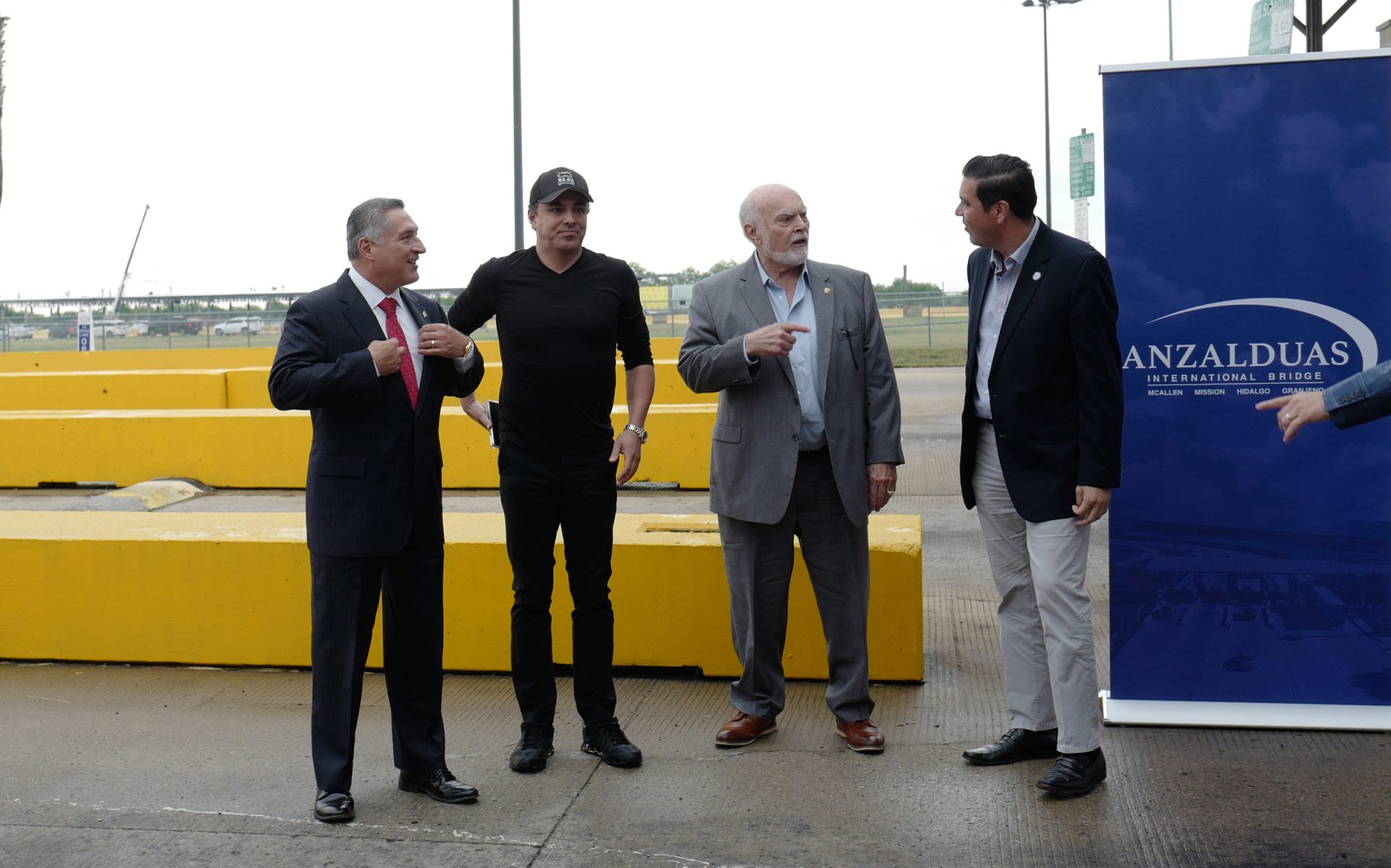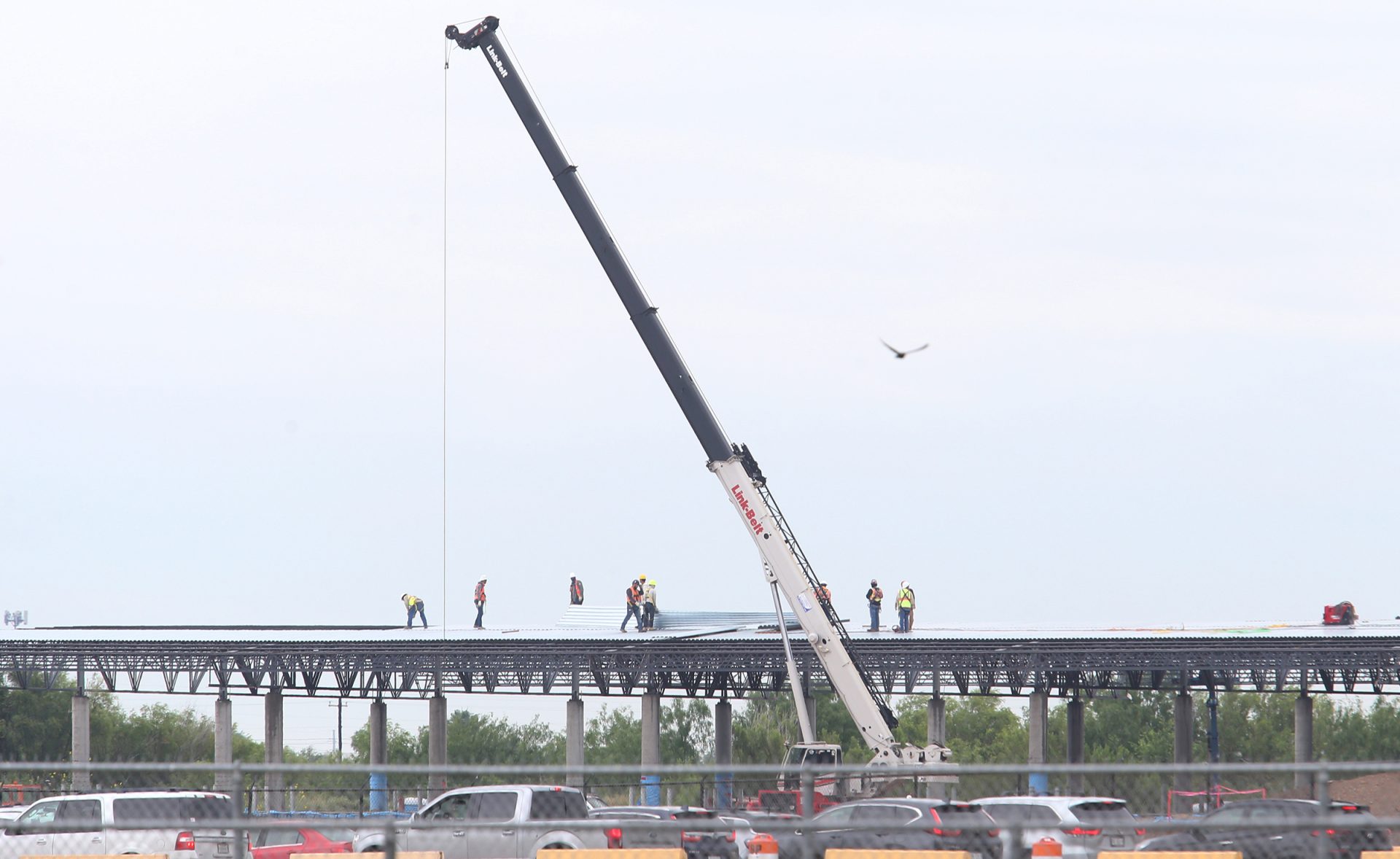|
Only have a minute? Listen instead |
MISSION — “We’re not the sleepy little cities we used to be, especially the McAllen area, Pharr (and) Mission. We keep growing. It’s amazing what’s going on,” McAllen Mayor Javier Villalobos said amidst a gaggle of local officials on Monday.
The group had gathered at the Anzalduas International Bridge south of Mission for a roundtable with state transportation officials and legislative leaders.
At the heart of their discussions, Villalobos said, was the Rio Grande Valley’s growing role not just in the national economy, but in international commerce, as well.
“The economic impact that our area provides is just incredible for the state and for the country,” the mayor said while behind him, passenger cars and empty 18-wheelers roared past toward Mexico.
“We’re talking about billions and billions and multi-billions of dollars,” Villalobos added.
Nearby, crews manning heavy machinery were hard at work on an $83 million project to expand the bridge’s capacity for commercial traffic.
The project includes the construction of northbound lanes for fully-loaded cargo trucks coming into the country from Mexico, as well as an inspection station, cargo bays, docking stations and more.
Currently, the bridge’s nine southbound lanes are dedicated to passenger vehicles and so-called “empties” — commercial trucks that have already unloaded their cargo on this side of the border.
The commercial expansion of the bridge — which is jointly owned by the cities of McAllen, Mission, Hidalgo and Granjeno — has been in the works for years. And its realization comes not a moment too soon, according to state Sen. Juan “Chuy” Hinojosa, D-McAllen.
“Our trade with Mexico continues to grow every year by leaps and bounds in the billions of dollars, so we need to make sure that we’re able to accommodate and expand our capacity to deal with all the commercial trucks coming across,” Hinojosa said.
Construction is expected to be completed by next February. Once the northbound lanes are completed and opened for traffic, Anzalduas will become just the second port of entry in Hidalgo County with the capacity for both north and southbound traffic.
However, there are still more infrastructure needs within the region — including additional funding that is needed to tie the binational trade corridor together.
“Right now, we need an additional $20-50 million to be able to complete the connector to the 281 expressway north of Edinburg,” Hinojosa said.

At the same time the bridge is undergoing an expansion, local leaders are also looking at another ongoing project — the International Bridge Trade Corridor, or IBTC — that will expedite commercial traffic from Hidalgo County’s international bridges to the interstate system.
The 13-mile, four-lane highway system is planned to traverse between Donna and Pharr.
It was that and other large-scale infrastructure needs that prompted Monday’s roundtable, which was hosted by the city of McAllen.
“Today, we were here discussing some of the potential costs of … some of the projects we’re looking at. And I think they paid attention,” Villalobos, the McAllen mayor said.
The “they” Villalobos was referring to were key officials within the state legislature’s transportation committees, including state Rep. Terry Canales, D-Edinburg, and state Sen. Robert Nichols, R-Jacksonville.
The two men serve as the transportation committee chairs for their respective legislative chambers and have their fingers poised on the trigger of billions in highway funding.
Hinojosa, who serves as the vice chair for the Texas Senate Finance Committee, said bringing the transportation officials to the border is important for them to understand that the state’s funds are being well and wisely spent.
“If we are to ask for more funding from the state, we have to show that we already spent what the state provided and appropriated and that progress that we are making,” Hinojosa said.
In addition, such visits allow lawmakers like Nichols — whose legislative districts lie far from the communities that benefit from his decision-making — to see the broader impact of those choices.
“It is imperative that our elected officials from other parts of the state understand how it’s all interconnected,” said Pedro Alvarez, engineer for the Pharr District of TxDOT.
Alvarez spoke of how a significant number of goods cross into the U.S. through the Valley’s ports of entry, including the more than two-thirds of produce sold in Texas that crosses in Pharr each year.

Other goods are transported to the Midwest, New York and other locations north.
“When you start thinking of how this region affects not only the state, but the entire nation, it’s really, really important,” Alvarez said.
And that’s important for decision makers like Nichols and Canales to see for themselves.
“In time of picking projects, identifying projects, we’re bringing the attention to these much-needed projects in our region,” Alvarez said.
While officials may have only taken a look at the progress of the Anzalduas expansion Monday, it’s not the only bridge where big things are happening.
Further east, the city of Donna is also looking to expand its bridge.
This week, early voting got underway on a $45 million bond referendum the city hopes will fund the construction of two northbound commercial lanes at the Donna-Rio Bravo International Bridge.
And earlier this month, Republican Sen. John Cornyn paid a trip to Veterans International Bridge in Brownsville to celebrate expansion efforts there.
As the bridge and highway system continues to grow, so, too, will the Valley economy, Hinojosa said. And part of being able to expand those systems is by requiring local leaders to shift to a “new mindset.”
“Instead of having the Friday night football mentality, what you now have is focusing on the region as a whole,” Hinojosa said.

